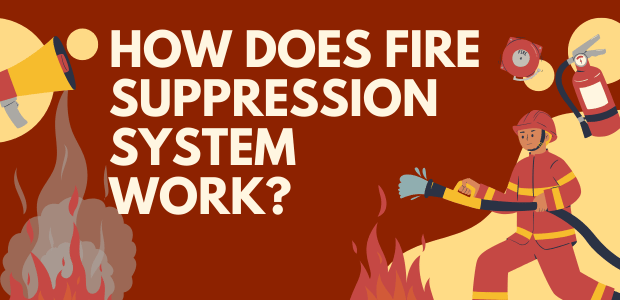How Does Fire Suppression System Work?

- March 27, 2025
- Interface Digital
Fire safety is a crucial aspect of protecting lives and property in residential, commercial, and industrial spaces.
Fires can cause catastrophic damage within minutes, making it essential to have reliable automatic fire protection in place to detect and suppress them quickly. This is where fire suppression systems are helpful.
But, how does fire suppression system work?
In this blog, we are going to answer this question, also we will also uncover types of fire suppression systems, components, benefits, and more. So let's begin.
What is a Fire Suppression System?
A fire suppression system is a specialized setup designed to detect and extinguish fires automatically or manually before they cause extensive damage. It relies solely on water and also uses a variety of agents like gas, foam, and chemicals to suppress flames effectively.Key Components of a Fire Suppression System
- Fire Detectors – Smoke, heat, and flame detectors that identify early signs of fire.
- Control Panel – The brain of the system that processes signals and activates suppression mechanisms.
- Suppression Agents – Water, gas, foam, or chemical agents are used to extinguish fires.
- Dispersal Mechanism – Sprinklers, nozzles, or pipes are used as the suppression agent.
- Alarm and Notification System – These systems alert building occupants and emergency services.
How Does Fire Suppression System Work?
Fire suppression systems operate through a structured process that ensures quick fire detection, activation, and suppression.1. Fire Detection Mechanism
Modern fire suppression systems use smoke, heat, and flame detectors to identify potential fires. These detectors send signals to the control panel, which then determines if suppression measures should be activated. Early warning alarms alert occupants, giving them time to evacuate safely.2. Activation Process
Fire suppression systems can be either automatic or manually activated. Automatic fire suppression systems are triggered when sensors detect a fire, while manual activation requires human intervention via pull stations or remote controls. Once activated, the system initiates the suppression process based on the type of suppression agent used.3. Suppression Agent Release
Depending on the type of fire suppression system installed, different suppression agents are deployed:- Water-Based Systems – Disperse water through sprinkler heads.
- Gas-Based Systems – Release gases like CO2 or FM-200 to eliminate oxygen and suffocate the fire.
- Foam Suppression Systems – Discharge foam to blanket the fire and prevent reignition.
- Chemical Suppression Systems – Use dry or wet chemicals to smother flames.
Key Benefits of a Fire Suppression System
As we now know how does fire suppression system works, we will look into its benefits. Benefits are mentioned below:- Rapid Fire Control – These systems suppress fires quickly, preventing further spread.
- Damage Reduction – It limits property damage and business disruptions.
- Protection of Critical Assets – It is essential for data centers, industrial facilities, and restaurants.
- Compliance with Fire Safety Regulations – It ensures adherence to safety codes and regulations.
Types of Fire Suppression Systems
Fire suppression systems come in various types, each designed to combat specific fire hazards.1. Water-Based Fire Suppression Systems
- Sprinkler Systems – A traditional system that releases water to control fires.
- Water Mist Systems – Uses fine water mist to cool and suppress flames efficiently.
2. Gas-Based Fire Suppression Systems
- CO2 Systems – Remove oxygen from the fire’s environment to suffocate flames. In this blog, we are going to further discuss CO2 systems.
- FM-200 Systems – A clean agent gas system that quickly suppresses fires without harming electronics.
- Inert Gas Systems – Gases like nitrogen and argon are used to suppress fires safely.
- Preaction sprinkler systems: Instead of water, pre-action systems use compressed air or nitrogen to control fire.









